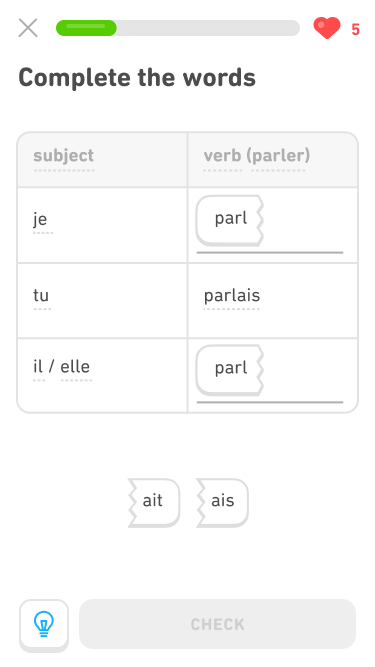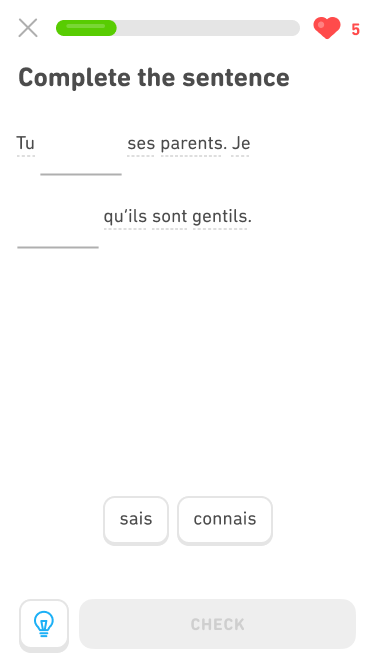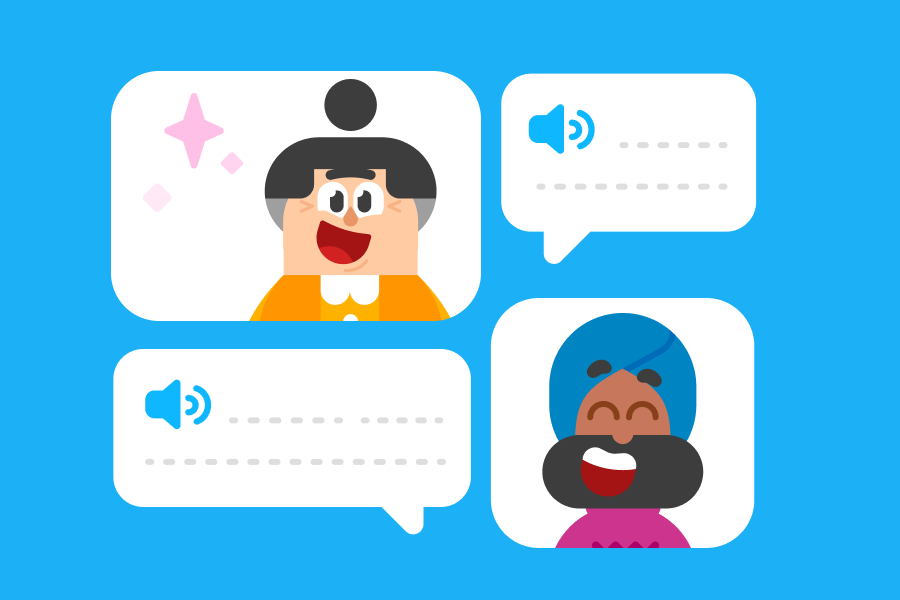Language is more than a collection of words — and grammar is the glue that holds those words together. Grammar tells you how to combine words, phrases, and even things like word endings so that you can understand those around you, and so you can be understood yourself. In this post, we’ll discuss the best ways to learn grammar and how we're using learning science in Duolingo's newest grammar-focused teaching tool, Grammar Lessons!
Why is it so important to learn grammar?
Different languages have different rules about how you can combine words to form sentences, how to talk about things happening at different points in time, how to address people in formal and informal situations, and much more! For example, word order matters a lot in English. Think about the sentences "The cat eats the mouse" and "The mouse eats the cat." The words used are exactly the same, but changing the order of the words changes the entire meaning! That's not the case in languages like Russian, which has grammatical case: the endings of words tell you who does what, and not the order. (In fact, in Russian the words can go in all kinds of orders without changing the meaning.) You can see how knowing these rules helps you comprehend and communicate in a language.
When you learn a language as a kid, you learn all the grammar rules without thinking about it. You pick them up implicitly without having to be told about word order, verb endings, and a lot of other details. When you're learning a language later in life, learning the grammar can feel like one of the hardest parts, especially if the rules are very different from other languages you know.
That's why for teaching adult learners, Duolingo uses a combination of implicit and explicit instruction! In regular lessons, we teach grammar implicitly: You see different types of language structures in phrases and you interact with them in different ways (sometimes you're listening, sometimes matching, sometimes writing, etc). But we also use explicit teaching to give you more information; in explicit teaching, we tell you how a rule works by giving you an explanation. You'll see explicit teaching in Smart Tips, which pop up with grammar information after you've made a mistake. But for some grammar topics, it can be hard to get enough practice when you're also learning new vocabulary, practicing listening and speaking, etc. This is where our new Grammar Lessons come in!
Grammar Lessons: A new approach to grammar teaching
Grammar Lessons provide targeted grammar instruction and practice, using implicit and explicit teaching. These lessons are designed to make grammatical patterns more salient — that is, more noticeable.
Grammar Lessons feel a lot like the typical Duolingo lessons you already know well, but there's a lot that's all new, too. First, they focus on grammar only—you won't see new vocabulary, so you can really focus on just the grammar topic. Grammar Lessons also use some new, more grammar-focused exercises. These are designed to focus your attention on the patterns being taught, and they scaffold your learning by starting with easier exercises and building up to harder ones as you practice more.
- When you start a Grammar Lesson, you'll get some explicit instruction before the lesson in a tip, and you can always click on the blue light bulb at the bottom to refer back to the tip during the lesson!
| Pre-lesson tip | In-lesson tip button |
|---|---|
 |
 |
- Grammar Skills help you focus on grammatical rules with brand-new exercises. Table exercises like this one on the left make it easier to notice patterns in verb endings. Exercises with two blanks are great for rules about tricky contrasts. Did you know French has two different ways to say "to know"? The exercise on the right helps you practice when to use each one!
| Table exercise | Choose the correct form: meaning differences |
|---|---|
 |
 |
- Grammar Skills also use scaffolding: exercises gradually build up your knowledge using what you already know. Early in a lesson, you might select the correct ending from a list of options. And then later, when you've practiced more, you'll type it yourself to really reinforce your knowledge!
| Tap the ending | Type the ending |
|---|---|
 |
 |
Using research to improve grammar teaching
The Grammar Lessons you see today were carefully developed by harnessing three powerful resources: learning science research, learning data from the app, and the insights of our learners themselves!
Research in learning science shows that in order to progress with learning something, you need to maintain the right difficulty level — not too hard, but also not too easy — and that’s why our scaffolding approach is so crucial to teaching grammar. It's also really important to connect new material with what you already know by comparing and contrasting. This is especially true for language learners: The more we can help you make analogies between patterns you already know and the new ones, the better you'll learn them!
Another important part of Grammar Lessons development was analyzing learners' responses to the new lessons. One way we measure the success of new features is by how many learners complete a lesson once they've started it. If you feel frustrated, bored, or overwhelmed by a lesson, you're more likely to quit before finishing, and we can see this in our data. When we checked how often learners completed their Grammar Lessons, we got a surprise. Learners were just as likely to complete these grammar lessons as they were to complete a regular lesson, but learners were making more mistakes—almost twice as many! Mistakes are actually good for your learning, since they heighten your attention and help you search for other solutions, but we always want to balance some healthy mistake-making with good progress. But since so many learners were still completing the lessons, we knew we had gotten the learning science right: Grammar Lessons were somewhat more challenging than typical lessons...but they're the good kind of challenging that learners appreciate, and so learners were happy to power through the rest of the lesson.
In fact, we found other evidence that the Grammar Lessons were working, too. We looked closely at the kinds of mistakes learners made, to see if doing the lessons really helped teach those topics. We gave a new set of lessons about the present tense in French to a small percent of learners, and we compared their mistakes to the mistakes made by learners in the regular French course, without the additional set of lessons. Learners who completed the present tense Grammar Lessons made fewer present tense-related mistakes afterwards than learners who didn't have that skill in their course. The Grammar Lessons really were helping learners reinforce their understanding of the present tense!
The third kind of research we used was talking to real learners like you! We contacted users learning French and set up virtual Grammar Lessons interviews: We'd meet with an individual learner, show them the kinds of exercises and topics we'd want to cover, and get their feedback. We got to hear about how the new lessons felt, what learners wanted more of, and what we could do differently. These learners told us that this more-challenging content felt rewarding, and even fun, because they got to feel like they were identifying patterns and “solving a puzzle.”
We applied science, data, and learner feedback to help us perfect the new Grammar Lessons: they might feel slightly more challenging than regular lessons, and that's because they give you the opportunity to solve grammatical puzzles. So if you feel like Grammar Lessons are harder than other lessons, rest assured that this challenge has been carefully calibrated for learners like you!
Helping you see grammar more clearly
Studying the grammar of the language you're learning is all about communicating—we want you to get comfortable expressing yourself and understanding others, with just the right details and nuance. That's why our new Grammar Lessons use a combination of explicit and implicit teaching to get you noticing and learning patterns in a fun and rewarding way.



